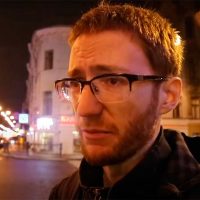Investigative
Reporting
Award
Brutalised Minsk: how Belarusian police beat protesters
published by Mediazona, Belarus
Mediazona received access to data held by Belarus’ Investigative Committee. These data show that the minimum number of people who suffered violence during protests in August and September this year is 1,406. This is the number of people that the Belarusian authorities clearly know suffered violence from law enforcement officials. But despite this official data, the authorities are yet to investigate the violence, and not a single criminal case has been opened so far.
In this article, Mediazona shows how Belarusian law enforcement beats — systematically and with complete impunity — protesters. The text was translated by openDemocracy, and is published on their website.
“Everyone was on their knees, they kept on cramming people into the bus. And then the violence started. The riot police officer said that we had to get up as fast as we could, grab our things and leave the bus. And they started beating people until they stood up. One of them would hold someone while the other beat them. They were just beating and saying: ‘What did you want, bitch, change?'”.
This is how one resident of Minsk describes his arrest on 9 August — alongside thousands of others, journalist Alyaksei Khudanau had gone out to protest against Belarus’ election results after Alyaksandr Lukashenka had been declared the winner. Official results awarded Lukashenka 80% of the vote, but a significant number of Belarusians are sure that the results were falsified, and that Sviatlana Tsikhanouskaya, the only independent candidate, is the real winner of the election. Other candidates were forced to either leave the country or have been arrested, including Tsikhanouskaya’s husband, the popular video blogger Siarhei Tsikhanousky.
The protests have not let up since. Every week, tens of thousands of residents of Minsk, the capital, and other cities come out onto the streets. In Minsk, the numbers of attendees have exceeded 100,000 — a huge figure for a city of two million. In response, Belarusian police have used riot batons and water cannons to disperse people.
The police response was particularly brutal immediately after the election, when masked police officers detained people across Minsk, shooting flash grenades and rubber bullets at crowds, beating people on city streets, police vans and police stations. Several people died amid the violence: a special forces officer shot protester Aliaksandr Tarajkouski dead in Minsk; in Brest, a plain clothes police officer shot Hienadz Shutau, a biker; and Mikita Kryutsou, a football fan, died in unclear circumstances in Maladzyechna (the official version is suicide).
The exact number of people who have suffered at the hands of the Belarusian police is unknown. Belarusian state agencies do not publish statistics on violent incidents involving the police, but as we have discovered — they do collect this information. Mediazona recently received a data archive held by Belarus’ Investigative Committee from an anonymous source. These data consist of several spreadsheets containing information about individual instances of police violence, as well as inspections concerning reports of torture. Analysis of these documents shows that the minimum number of people injured by Belarusian police during protests in August and September 2020 is 1,406 people.
Meanwhile, Lukashenka refuses to negotiate with protesters, insulting them. Instead, he constantly thanks the Belarusian police in his public remarks. “You have stopped this trash on the clean, comfortable [streets] of Minsk,” Lukashenka said in late September. The Belarusian authorities have opened a criminal case into an “attempted coup of state power” by members of the Coordination Council, set up by the Belarusian opposition — of whom many have fled the country or are now under arrest. Ordinary protesters are also facing criminal cases. According to human rights defenders, 435 people are facing prosecution as a result of Belarus’ election campaign and the ensuing protests.
Despite the large number of injuries, the Belarusian authorities have not opened a single investigation into violence committed by police officers.
In order to read the investigation on Mediazona’s website and to access all interactive graphics, read here.
Why we trust this data presented by an anonymous source
Mediazona was already familiar with one of the documents in the archive — a spreadsheet of injuries inflicted by flash grenades, rubber bullets and tear gas. We had already received this document from a different anonymous source. Part of the records were accompanied by the names of hospitals in Minsk where injured people were taken. We showed this information to sources in Minsk City Hospital No. 10 and the city’s clinical emergency care hospital. In the latter, our data matched the hospital’s entire list of patients for that time, whereas our source in Hospital No. 10 stated that two of the people in our list did not contact them for medical treatment.
Many of the more serious cases connected to protesters’ eye injuries, amputations, comas and deaths have been described by journalists previously, including by Mediazona. Descriptions of these incidents matched information held in our archive.
We also checked information concerning beatings at Minsk’s Akrestsina jail against prisoner lists compiled by the Viasna human rights centre. The team also showed the documents to a source in one of the Investigative Committee’s central directorates. They confirmed the spreadsheets and other documents were genuine.
How we analysed the severity of the injuries
The Investigative Committee’s documents report medical diagnoses given to protesters, and from the majority of diagnoses it is clear how exactly protesters were injured. We have visualised these injuries via silhouettes representing each of the 1,406 people injured.
We categorised injuries by severity — light injuries (1), medium injuries (2) and heavy injuries (3). If part of someone’s body was not injured, we indicated it (0 points). We also analysed injuries in terms of how they were inflicted — beating, rubber bullets, flash grenades or gas.
We categorised bruising, contusions and light burns as light injuries; lacerated wounds, head injuries and multiple traumas — medium; and firearm wounds, internal injuries, broken bones and amputations — heavy.
With the average age of an injured person coming to 31, young men were most likely to be injured at the protests. The worst injuries came from rubber bullets and flash grenades.
Belarusian police aimed for protesters’ vital organs
Judging by injuries caused by rubber bullets (40 cases), it is clear that police officers often shot people in the head, chest and stomach when dispersing protests — and these weapons caused the most serious injuries. On 10 August, 34-year-old Aliaksandr Tarajkouski died from a rubber bullet shot to the chest — holding his hands in the air, he had approached special forces officers near the Pushkinskaya metro station in Minsk.
One 24-year-old protester received a rubber bullet to the stomach, leading to a hernia of the small intestine; another participant, a 37-year-old businessman, had his rib cage penetrated by a rubber bullet, causing damage to his right lung. Doctors diagnosed him with open pneumothorax, where air accumulates between the chest wall and lung after an open chest wound — which in serious instances can lead to a collapsed lung.
“I was in a coma for three days, but I was awake for a few moments. The doctors say it’s rare, but it happens,” recalled Aliaksandr Pastukhau, whose lung was penetrated by a rubber bullet. “I remember how they cut my clothes off. The doctors’ speaking when they tried to straighten out my lung during the operation. And how my brain was panicking: it’s sending signals, but my body isn’t responding. And it was terrifying that I could wake up with brain damage. It’s surprising that they shot from such a short distance at my chest. In a way, it’s good they shot me in the right lung. If they’d shot me in the left, we might not be speaking now.”
When police fired rubber bullets at protesters’ heads, they caused head traumas and broke facial bones. For instance, the data shows how a 40-year-old man wound up in hospital with the following diagnosis: “closed head trauma, concussion, multiple gunshot injuries to the right jaw.” His rib cage, stomach and left thigh were also injured. Another protester, 29, was hit by a rubber bullet, which smashed through his maxillary sinus, just behind his cheek, fracturing his nose. Another person was shot with a rubber bullet in the eye, receiving a serious contusion.









